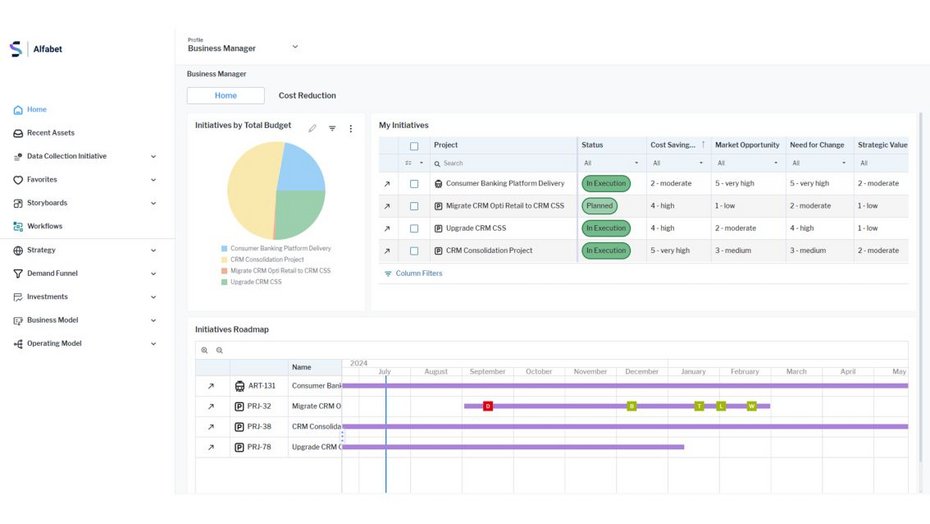Overview
Digital business managers must rapidly adapt their strategies quickly and effectively to align with shifting market conditions and corporate goals. As digitalization transforms business and operating models, the interdependencies between business and IT become increasingly crucial to map, analyze and understand. IT functions as the production plant for the digital business. Often, though, it poses obstacles instead of enabling business strategy. Common issues include inflexible IT structures, overdue projects, and diminishing returns on IT investments. Fortunately, help is here. Digital business managers at leading international companies are leveraging strategic portfolio management (SPM) and enterprise architecture (EA) capabilities to achieve their goals. Are you interested in bringing a new dimension the business-IT relationship?
Harnessing IT's full potential
We’re in a new era of business operations where digital products and services dominate, and nearly everyone within the organization has a vested interest in IT. As a digital business manager, you should have the tools available to ensure that business and IT are aligned and that IT is delivering on strategies such as cost cutting, process improvement, product innovation, new product introduction, and acquisitions.
You own the IT budget for your area of responsibility and sponsor major digital transformation projects. However, these powers are only effective if you also establish the right governance and transparency in the business-IT interaction. Without governance and transparency, the success of any IT investment becomes unpredictable. Addressing the following challenges is essential to harnessing IT's full potential:
Do business analysts have the right tools to articulate business strategy and demand?
Are methodologies such as SAFe for Agile development and delivery implemented? If not, IT will struggle to follow your lead.
Can IT express strategic scenarios for enabling business strategy?
IT plans and road maps for enabling the business strategy should be understandable to business peers to ensure collaboration and achieve your digital business strategy.
Are IT investment decisions based on clear financial and risk information?
If you're funding IT investments required for digital products and services, knowing cost drivers and risks to business continuity is essential to making economically sound decisions and avoiding unnecessary risks.
Is there a planning process that brings together business analysts, the PMO, and enterprise architects?
This can ensure that IT investments are achievable, accepted and deliver the best return on investment. If not, you will be losing money invested into IT.

Find the answers with SPM and EA
With SPM and EA, best-in-class digital business managers implement the necessary process and governance in the business-IT relationship. This approach supports all the relevant stakeholders with core capabilities to meet the challenges of harnessing IT’s full potential, such as sponsoring digital transformation programs, achieving acceptable levels of IT flexibility and risk, and deriving the greatest value from IT investments. These key questions are answered by the following essential capabilities:
Business strategic planning
This capability enables businesses to express and develop its strategies, business models, processes and required business capabilities in a structured and analyzable format.
Business-IT relationship management
This provides a process-supported single point of capturing and prioritizing business demands, aligning them with IT strategies and road maps for impact analysis. This forms the foundation for optimal business-IT alignment.
IT planning
IT planning's goal is to convert business demands into executable and funded IT programs. It enables target architectures and scenarios to be iterated with the business and broken down into deliverable projects. The program portfolio process ensures that investment decisions are made with good governance, optimizing IT investment and closing the control loop, providing a platform for project monitoring and reporting.
IT financial management
Business managers require cost transparency across the IT landscape to make financially sound decisions on IT support. IT financial management provides this transparency, with cost-driver analysis highlighting areas for cost optimization—exposing process and capability costs. Furthermore, it supports efforts to optimize IT investments and monitor project and application budgets.
IT risk management
To ensure smooth business transformations and to avoid IT security incidents that could disrupt digital product and services, Digital Business Managers need IT risk transparency. IT risk management encompasses the necessary process support to integrate and assess information relevant to effective IT asset risk management compliance. This should be automated to ensure the costs of risk management and compliance are kept to an acceptable minimum.
Leader in SPM and EA
Internationally renowned companies across the globe use the market-leading solution for SPM and EA—Alfabet. The platform provides a set of core capabilities to sustainably manage and ensure IT’s contribution to business value. SPM and EA aim to plan and monitor the performance of IT support throughout its entire life cycle—ensuring that business strategy and demands are fully understood, prioritized and executed, and that the costs, quality and risks to IT support are known and considered during decision making.
Alfabet has been instrumental in bridging the gap between our IT and business teams, fostering a collaborative environment where we can work together to achieve our strategic objectives and maximize the value of our technology investments.
About Alfabet
Alfabet is a leading enterprise platform with standard modules that support effective Strategic Portfolio Management (SPM) and EA, offering:
- The richest set of artifacts in the industry
- A single, central repository
- Role-based access and support for global communities
- Decision-ready reporting and publication
- Advanced support for the agile enterprise
- Broad and easy-to-use configuration
- Use of leading-edge AI technologies
- Support for federated enterprises



